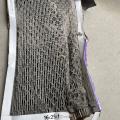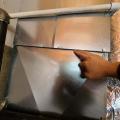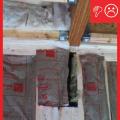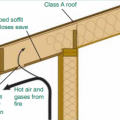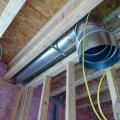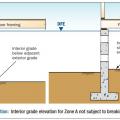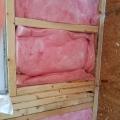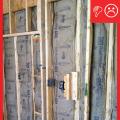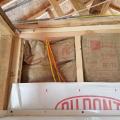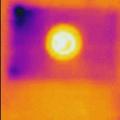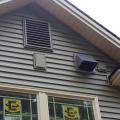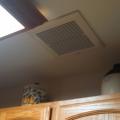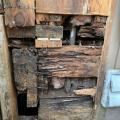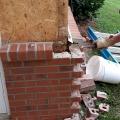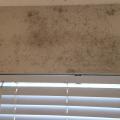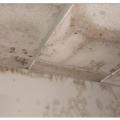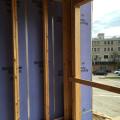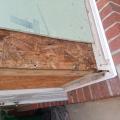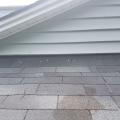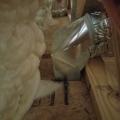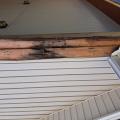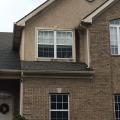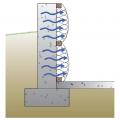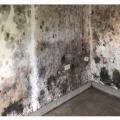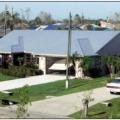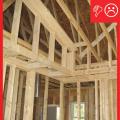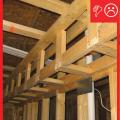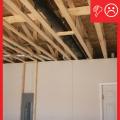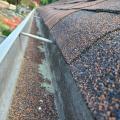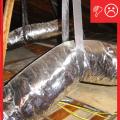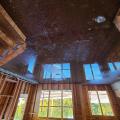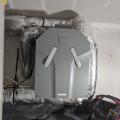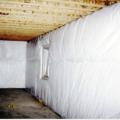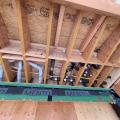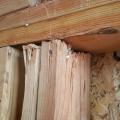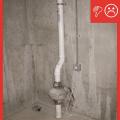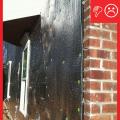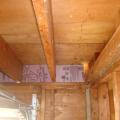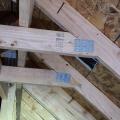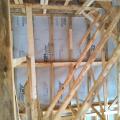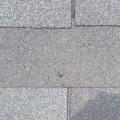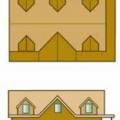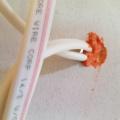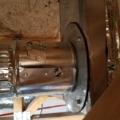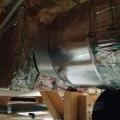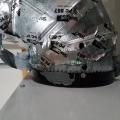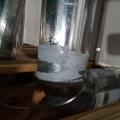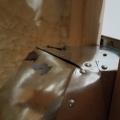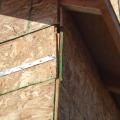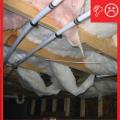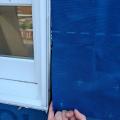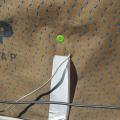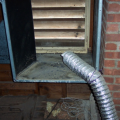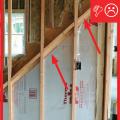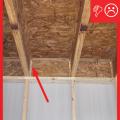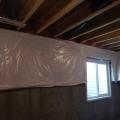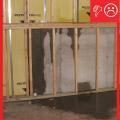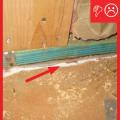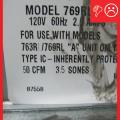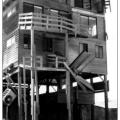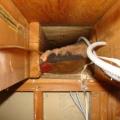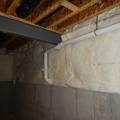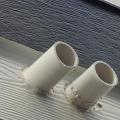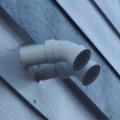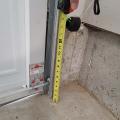Showing results 4501 - 4600 of 4973
Wrong - HVAC rigid metal duct seam needs to be air sealed with mastic or metal tape.
Wrong - If the soffit is applied directly to the rafter eave, it forms a sloping soffit, which creates a pocket that can trap hot air and embers from a wildfire.
Wrong - If this kitchen exhaust duct had been extended a few inches, at least one bend could have been eliminated.
Wrong - In floodplains, the interior grade elevation should be equal to or higher than the exterior grade as shown on right.
Wrong - Insulation beneath window is compressed and there are more support studs than necessary to left of window.
Wrong - IR image shows a lack of air-sealing and insulation around a ceiling light fixture.
Wrong - Kitchen exhaust ducts are prohibited from terminating within 3 feet of an operable window or near gable vents.
Wrong - Kitchen exhaust fans must be located directly over the stove top to be effective at capturing and removing cooking pollutants.
Wrong - Lack of a weather-resistant barrier allowed water to get behind the siding and rot the framing in this corner rim joist area.
Wrong - Lack of house wrap or weather resistant barrier lead to significant water damage behind the brick veneer.
Wrong - Lack of insulation in the wall above this window combined with poor bathroom ventilation has contributed to mold growth.
Wrong - Ladder framing method for a gable overhang offers low resistance to wind uplift.
Wrong - Leaks in the roof sheathing can allow water to get in and wet the drywall, providing fertile ground for mold.
Wrong - Membrane or sealant air seal is missing at the intersection of the party wall with the exterior wall in this multifamily building
Wrong - Metal flashing is bent and poorly installed and tape flashing is missing.
Wrong - Metal tape is poorly adhered and metal duct and duct-to-subfloor seam is not sealed.
Wrong - Missing kick-out flashing to divert rainwater runoff away from the house and into the gutter where the roof meets the wall has caused discoloration of the stucco and water damage behind the stucco by the front porch and the second-story window.
Wrong - Missing kick-out flashing to divert rainwater runoff into the gutter where the roof meets the wall has caused discoloration and water damage behind the stucco next to this second-story window.
Wrong - Moisture from within the basement foundation wall can migrate into the insulation cavity in a conventional blanket insulation installation.
Wrong - Mold can spread rapidly in flood damaged homes if materials aren't dried quickly.
Wrong - Nailing pattern on roof underlayment is erratic and excessive, house wrap should overlap seam, metal step flashing will need to be installed at roof-wall junction.
Wrong - Negative pressure from hurricane winds caused garage door to collapse inward.
Wrong - No air barrier is present between the dropped ceiling/soffit and the attic.
Wrong - No air barrier is present between the dropped ceiling/soffit and the attic.
Wrong - No air barrier is present between the floor system and unconditioned space.
Wrong - No air barrier is present in the floor joists spanning over the garage and conditioned space of the home.
Wrong - Not enough straps were used to hang this flex duct so it is sagging, restricting air flow
Wrong - Penetrations in walls for ducts should be air sealed to reduce air leakage.
Wrong - Plastic-covered blanket insulation that is installed directly against concrete walls with no rigid foam or closed-cell spray foam covering the concrete could trap moisture coming through the concrete, leading to mold, moisture, and odor problems.
Wrong - Plumbing penetrations are not sealed in sub-floor and it is not recommended to run plumbing in a cantilevered floor.
Wrong - Polyethylene sheeting should be lapped up sides of walls and pillars and taped
Wrong - Rigid insulation blocking is installed but not air-sealed with spray foam around edges.
Wrong - Roof deck sheathing nails missed the trusses, potentially weakening the roof in high winds.
Wrong - Roof is missing metal drip edge to cover the edge of OSB roof decking, roof underlayment should be trimmed back, and asphalt shingles are poorly installed.
Wrong - Roof-wall juncture lacks metal flashing and is poorly designed, thus encouraging water entry.
Wrong - Roofs with complex geometries are more susceptible to ignition during a wildfire because they offer more places for burning embers to become lodged.
Wrong - Self-adhered house wrap is poorly installed with many bubbles and gaps at seams.
Wrong - Self-adhered house wrap is underlapped instead of overlapped which will allow rain water to get behind house wrap.
Wrong - Step flashing is missing where the gable meets roof and the valley flashing is incorrectly on top of rather than under shingles.
Wrong - Stucco has rotted and cracked above a window because of water damage due to lack of proper flashing and drainage.
Wrong - Tape is not well adhered to house wrap and wiring penetration is not sealed.
Wrong - The air barrier is not sealed (picture taken from garage looking into house).
Wrong - The band joist above this garage-house shared wall is not properly sealed.
Wrong - The basement blanket insulation is loosely attached to the interior of the basement wall, does not cover the entire wall, is not sealed at the edges, and is not installed over rigid foam that covers the entire surface of the foundation walls.
Wrong - The below-grade concrete does not have the correct construction to be impermeable to moisture because the lumber is untreated and against the concrete that lacks waterproofing.
Wrong - The caulk is too far from the sill plate to effectively air-seal the gap.
Wrong - the CFM rating may not meet the performance specification once installed, and the sone rating is too high.
Wrong - The faced batt insulation does not provide an air barrier in the joist bay between the garage and the conditioned space of the home.
Wrong - The fiberglass blanket insulation has no perforated vapor retarder, does not cover the entire basement wall, is not sealed at the edges, and is not installed over rigid foam.
Wrong - The furnace intake and exhaust are too close to each other and are missing rodent screening.
Wrong - The furnace intake and exhaust are too close to each other and should be facing different directions.
Wrong - The garage door sensor is too high and it should be 4 to 6 inches from the ground.
Wrong - The ground of the crawlspace should be covered with a vapor barrier that extends up the sides of the crawlspace.
Wrong - The gutter is missing kick-out flashing causing wall and window damage beneath it.
